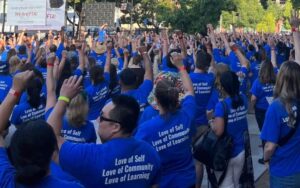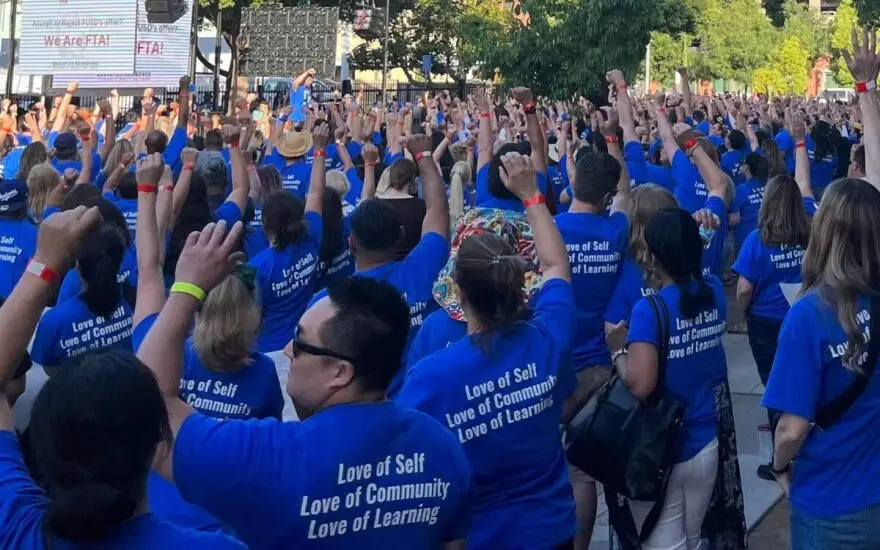 Unionized teachers in Fresno – California’s fourth largest district – are threatening to strike. In addition to pushing for increased pay and better benefits for staff, the Fresno Teachers Association is asking for additional student supports, particularly for homeless families. But those ideas go beyond the teachers contract and shouldn’t be a part of bargaining, district officials have said, according to EdSource.
Unionized teachers in Fresno – California’s fourth largest district – are threatening to strike. In addition to pushing for increased pay and better benefits for staff, the Fresno Teachers Association is asking for additional student supports, particularly for homeless families. But those ideas go beyond the teachers contract and shouldn’t be a part of bargaining, district officials have said, according to EdSource.
These “common good” demands, which are focused on social conditions affecting broader constituencies, rather than the conditions affecting workers in the bargaining unit, are increasingly common in education and other industries with unions, from higher education to health care to the auto industry.
“Today’s strikes are part of a clear shift in public consciousness and collective worker commitment to social, political, and economic change,” said Veena Dubal, a labor law expert, in an interview with PBS NewsHour.
We watched a similar scenario unfold last year in the Oakland Unified School District, when teachers walked off the job and halted instruction for eight days. The district had already agreed to hike pay for teachers in a new bargaining agreement. But, the Oakland Education Association followed an approach pursued by teachers’ unions in cities such as Los Angeles, Chicago, and St. Paul to seek “common good” contract provisions intended to help Black, immigrant and low-income families, and more generally, progressive causes.
There is something old and something new about teacher unions’ pressing for broad improvements in social conditions. Union lobbies in state capitols, always focused on raising K-12 spending and better wage scales for teachers, have also joined coalitions in favor of legislation to benefit the poor, immigrants, and LBGTQ communities. What’s new is pursuit of these “common good” agendas through local collective bargaining.
Union leaders in education as well as in the private sector are candid about why this is happening: post-pandemic labor shortages and a pro-union shift in public opinion have increased unions’ bargaining leverage. Though K-12 unions bargain only with school boards, leaders hope that district officials once committed to common good provisions will both change their spending priorities and influence city and county governments. Teachers, they expect, will benefit if children are less burdened by poverty and societal stress. As recent CRPE studies have shown in the aftermath of the pandemic, city schools are more burdened than ever by community health fears, street violence and challenges of student mental health, attendance and behavior. In pressing for “common good” provisions, unions are representing member concerns.
Pressing for common good provisions in collective bargaining can also strengthen unions’ ties with progressive groups, including environmentalists, supporters of immigrant rights and Black Lives Matter. In the near future, however, conditions might be less favorable, as enrollments decline and the end of pandemic-era federal grants tighten districts’ budgets. Will teachers support their unions in pursuing “common good” agendas even when jobs and raises are less secure? Will parents push back against strikes in pursuit of objectives other than salaries and working conditions (as happened in Oakland)? Could the new “common good” provisions already won become dead letters, if districts prove unable or unwilling to deliver on promises made in collective bargaining? Or will unions continue to seek broad social objectives via collective bargaining, even in tougher times?
This blog post is the first in a series about common good collective bargaining. Below, we describe how common good bargaining has become a national movement. In a subsequent post we’ll discuss the most recent instance of successful K-12 common good bargaining, in Oakland. Later we’ll assess whether common good provisions once established through collective bargaining are effectively influencing local district actions.
Common good bargaining as a national movement
Local unions are drawing ideas and training from a national network of university-based centers and nonprofits called Bargaining for the Common Good (BCG). These centers include Georgetown University’s Kalamanovitz Institute for Labor and the Working Poor; Rutgers University’s Center for Innovation in Worker Organization; and the Action Center on Race and the Economy, BCG, with direct funding and contributions from its component organizations, convenes local union leaders, provides national workshops on bargaining tactics and formulates expansive lists of possible common good provisions. The network employs experienced operatives from unions as diverse as the Postal Workers and the Service Employees International Union. An example of the component organizations’ racial justice, pro-labor and anti-capitalism missions:
ACRE is committed to winning transformative policies and political leadership that challenge the foundations of racial capitalism. We are fighting for a world where Black, Brown, and Indigenous communities are invested in and cared for, instead of being commodified for labor, corporate profits, and political gains.
BCG’s website provides 16 pages of provisions its members have sought. Four pages with 39 items are devoted to education, featuring demands made in labor negotiations in places as diverse as Boston, Chicago, Los Angeles, Philadelphia, Denver, San Francisco, Oakland, Seattle, Milwaukee, and the state of Oklahoma. Though not all these demands have made it into final collective bargaining agreements, BCG encourages member unions to keep pursuing them.
The list of BCG bargaining objectives is not tightly organized. They include provisions long-sought by teachers unions — smaller class sizes, limiting standardized testing, restorative practices in student discipline, and cracking down on charter schools. None address ways to help students who lost learning during the pandemic, but many come from far afield including:
- No cops in schools
- Shifting public funding from police
- No police at rallies
- Racial justice equity teams in schools
- A $1million district-supported legal defense fund for immigrants
- No privatization of public services
- Elimination of a check on job applications for past felonies
- No evictions or foreclosures from housing
- Stipends for childcare support
- Divestiture from Koch Industries
The Bargaining for the Common Good materials don’t set priorities or identify tradeoffs among the objectives. Local unions are free to pursue whatever common good provisions fit their localities and motivate their members.
The horizon for Teachers’ Unions
Teachers’ unions are morally committed to racial and economic justice and support for cultural and sexual minorities, believing that the right mix of public policies will eliminate barriers to kids’ learning. Common good bargaining complements other union political initiatives, including supporting candidates for public office and lobbying in state capitals. Unions also gain because these moves solidify support among younger members, who benefit less than senior teachers from contract wins on benefits and job protections, but who favor progressive social change agendas.
But there could be some political costs: Local union leaders who seek broad influence on social policy might clash with general government officials in charge of police, immigration, housing and environment policies. As became evident recently in Oakland, teachers unions might also lose support from parent groups who stand behind high salaries and good working conditions for educators but resent having schools closed over other issues. As districts encounter hard financial times, it could be more difficult for unions both to satisfy their members on job preservation, wage, and hour issues and to pursue broader policy goals. Even after school boards accept common good provisions, union memberships could split if a vocal minority of teachers wants to strike over disappointing implementation, but most teachers want to work and get paid.
Common good bargaining is now woven into national unions’ guidance to locals, and into the agendas of union instruments like the Albert Shanker Institute. Though national and local unions might need to go slow during periods of fiscal retrenchment, they are unlikely to abandon aspirations for greater influence and broader coalitions. It remains to be seen whether common good provisions lead to real changes in district actions and improvements in education for disadvantaged kids.




